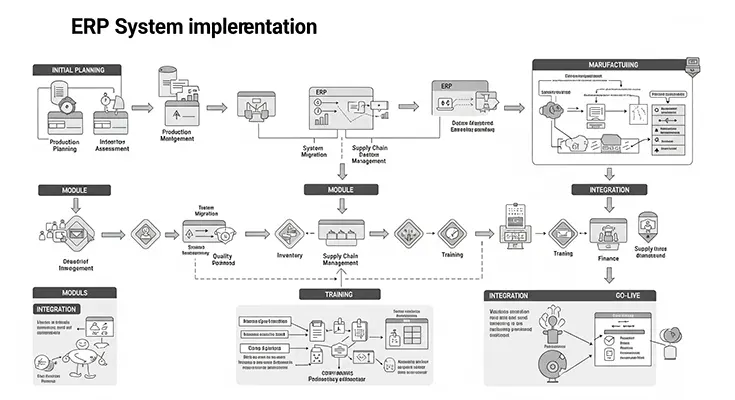Implementing an Enterprise Resource Planning (ERP) system in manufacturing companies can significantly improve efficiency, streamline processes, and enhance overall performance. However, the process of implementing an ERP system can be complex and challenging. To help manufacturing companies navigate this journey successfully, here is a comprehensive ERP system implementation guide tailored specifically for the manufacturing industry:
1. Define Clear Objectives and Requirements
Before embarking on an ERP system implementation, manufacturing companies should define clear objectives and requirements. Identify key pain points, inefficiencies, and challenges within your current systems and processes. Determine what specific goals you aim to achieve with the ERP system, such as improving inventory management, optimizing production planning, enhancing supply chain visibility, or increasing operational efficiency.
2. Conduct a Thorough Needs Assessment
Conduct a thorough needs assessment to understand the specific requirements of your manufacturing operations. Evaluate different ERP solutions in the market and assess how well they align with your business needs. Consider factors such as scalability, flexibility, industry-specific functionality, integration capabilities, and vendor support. Engage key stakeholders, including production managers, supply chain experts, IT professionals, and finance staff, in the needs assessment process to ensure all perspectives are considered.
3. Select the Right ERP System and Vendor
Selecting the right ERP system and vendor is crucial for the success of your implementation project. Choose an ERP solution that is tailored to the needs of manufacturing companies and offers modules for core functions such as production planning, inventory management, quality control, demand forecasting, and shop floor tracking. Evaluate vendors based on their industry experience, track record of successful implementations, customer support services, training programs, and future development plans.
4. Develop a Detailed Implementation Plan
Developing a detailed implementation plan is essential to ensure a smooth and successful deployment of the ERP system. Create a project timeline that outlines key milestones, tasks, responsibilities, and deadlines. Allocate resources effectively, including budget, staff, and external consultants if needed. Define a clear communication strategy to keep all stakeholders informed and engaged throughout the implementation process.
5. Customize and Configure the ERP System
Customize and configure the ERP system to meet the specific requirements of your manufacturing processes. Work closely with the vendor to tailor the system to your unique workflow, data structures, reporting needs, and integration with existing systems. Ensure that key modules such as inventory management, production scheduling, material requirements planning, and quality control are configured correctly to maximize the system’s effectiveness.
6. Provide Comprehensive Training and Support
Provide comprehensive training and support to users across all levels of the organization. Conduct hands-on training sessions to familiarize employees with the new system and its features. Ensure that users understand how to perform their day-to-day tasks within the ERP system and provide ongoing support to address any questions or issues that arise. Invest in training resources and documentation to empower users to leverage the full capabilities of the ERP system.
7. Conduct Testing and Quality Assurance
Before fully deploying the ERP system, conduct thorough testing and quality assurance to identify and resolve any potential issues or discrepancies. Test the system for data accuracy, functionality, performance, integration with other systems, and user experience. Engage end-users in the testing process to gather feedback and address any usability concerns. Conduct multiple rounds of testing to ensure that the system meets all requirements and expectations.
8. Monitor and Evaluate Performance
Once the ERP system is live, monitor and evaluate its performance to ensure that it is delivering the desired results. Track key performance indicators (KPIs) related to production efficiency, inventory accuracy, on-time delivery, cost reduction, and customer satisfaction. Analyze data generated by the ERP system to identify trends, inefficiencies, and opportunities for improvement. Continuously review and optimize the system to align with evolving business needs and goals.
Implementing an ERP system in manufacturing companies can transform operations, drive efficiency, and enhance competitiveness. By following this comprehensive ERP system implementation guide tailored for the manufacturing industry, companies can navigate the complex process with confidence and achieve long-term success. With thorough planning, strategic execution, and ongoing support, manufacturing companies can unlock the full potential of their ERP system and position themselves for sustainable growth and profitability.





